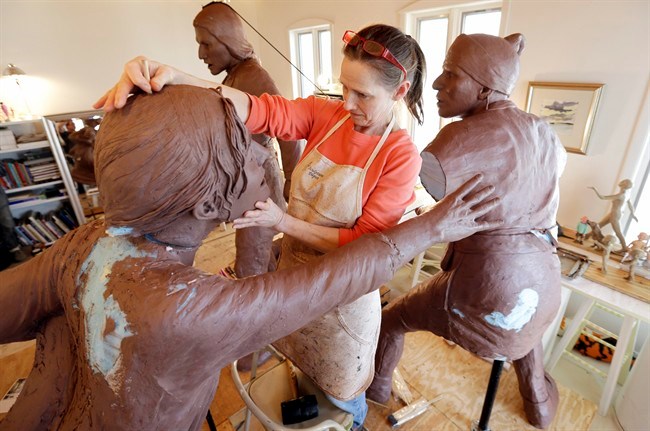LEWISTON, N.Y. - It could have become a forgotten moment in the "forgotten war."
Instead, a larger-than-life bronze monument will permanently recall a winter morning during the War of 1812 when the Tuscarora Indian Nation stepped between terrified families who were fleeing this riverfront village and the invading British-Canadian forces who were burning it down.
"Let's face it, not too many people appreciate or understand the War of 1812, let alone this 15 minutes," said Lee Simonson, director of the Tuscarora Heroes project of the Lewiston Historical Association.
As a belated thank-you to the western New York tribe, the association plans to dedicate the monument on the 200th anniversary of the burning of Lewiston, which will be re-enacted by modern-day residents and tribal members on Dec. 19, 2013.
As artist Susan Geissler prepared to ship her clay rendering to a foundry for its transformation to bronze, Simonson recounted the harrowing chapter in this quaint community's history and the modern-day debate over how to mark it for the bicentennial.
At least a dozen — and as many as 46 — men, women and children were killed in the Sunday morning invasion that left much of the village in ashes.
"Do we drown ourselves in tears talking about those British and how they destroyed us," Simonson said, "or do we concentrate on the bright side and illustrate the heroism and the bravery of a small group of about 25 Tuscaroras against 1,500 British?"
Historical Association President Bruce Sutherland said the monument is the among the largest war bicentennial projects that have been undertaken. With its $400,000 cost paid for through public and private sources, it honours a friendship between the Tuscaroras and Lewiston, he said, that has grown even stronger over the years.
"They've never been recognized like this before," Sutherland said.
For the 1,000 Tuscaroras now living on their Niagara County reservation, the monument will stand as a lesson, said Neil Patterson, a descendant of one of the "Tuscarora Heroes."
"I wish the history books would say this is a time when Indians actually helped non-Indians in battle," he said.
Patterson and others plan to participate in December's re-enactment of the burning of Lewiston.
The invasion was seen as revenge for the American troops' Dec. 10 burning of the Canadian town of Newark, known today as Niagara-on-the-Lake, just across the Niagara River. The Americans presumably had been hoping to deny British forces the shelter of the town, according to a historical account.
Nine days later, British soldiers and allied Native Americans, primarily Mohawk Indians, sailed boats to the American shore north of Buffalo, first capturing Fort Niagara before rushing into Lewiston with torches, guns and tomahawks.
"It was the 1813 version of shock and awe," said Simonson, author of "Tuscarora Heroes," which he wrote based on historical accounts.
As Lewiston villagers, some in bare feet and pyjamas, fled through mud and snow, two dozen Tuscarora men ran from their nearby hillside village, firing muskets and screaming a war whoop. The British, not knowing how few Tuscaroras there really were and fearing an ambush, halted their pursuit. That bought time for many of the villagers to reach safety.
"By this time, the train of white people had gone quite a good ways in their flight," Chief Elias Johnson wrote in an 1881 history of the Tuscaroras. "It is evident that the timely intervention of the Tuscarora Indians saved great slaughter of men, women and children among the white people."
Two days later, British forces went on to destroy what is now Niagara Falls, N.Y., and on Dec. 30, 1813, burned Buffalo to the ground, leaving western New York among the war's most battle-scarred regions of the United States. The White House, uncompleted Capitol building and several other public buildings in Washington were burned the following August, before the signing of the Treaty of Ghent in December 1814 brought an end to the war.
There are three pieces to the monument that Simonson and Geissler designed, each slightly larger than life: A barefooted woman, a baby in one arm, reaches with the other to the outstretched hand of a Tuscarora man while another Tuscarora looks protectively behind them.
"I want you to hear his voice when you look at him," Geissler said, gesturing to the largest of the clay figures soon to be transformed to bronze. His face and hands are carefully detailed and his clothing painstakingly replicated with the help of Tuscarora members. "When you look in his eyes, he's talking to you, you can hear him. You can hear him breathing. That's most important."



